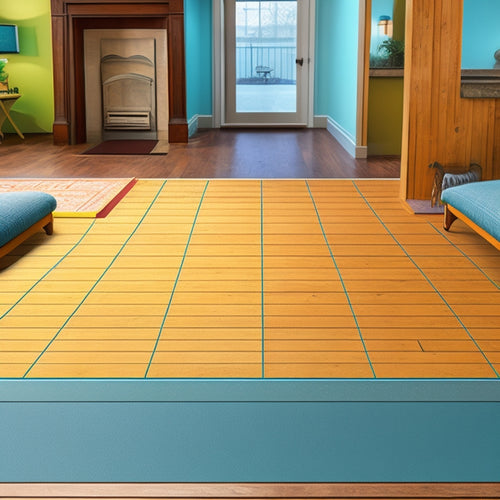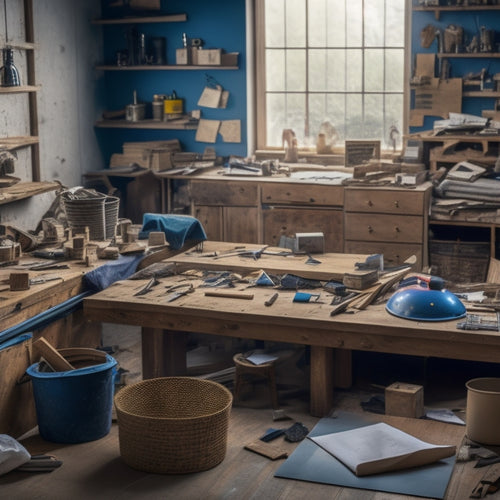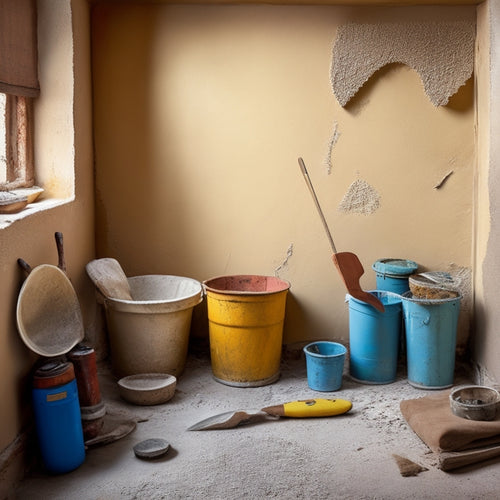
Wall Inspection Checklist for Home Renovation
Share
You're about to begin a vital phase of your home renovation project: a thorough wall inspection to guarantee your dream home is built on a solid foundation - literally. You'll start by preparing the site, checking for environmental hazards, and selecting sustainable materials. Then, you'll inspect the block wall foundation, verifying its levelness, drainage, and stability. Next, you'll evaluate block laying and mortar quality, followed by a wall dimension and alignment check. Finally, you'll confirm finishing and final inspections meet design specs and building codes. By following this meticulous process, you'll uncover essential details that will define your project's success - and there's more to explore.
Key Takeaways
• Inspect the site before construction to ensure it's clear, level, and compacted, with utilities marked and protected, and environmental hazards mitigated.
• Verify the block wall foundation is level, compacted, and graded to prevent water accumulation, with a suitable drainage system in place.
• Check block laying and mortar quality, ensuring blocks are level, plumb, and straight, with consistent mortar and no damage or irregularities.
• Measure wall dimensions and alignment against design specifications, checking for squareness, material quality, and structural integrity.
• Perform a final inspection to ensure all joints and seams are sealed, finished, and compliant with design specifications, codes, and regulations.
Pre-Construction Site Preparation
Before commencing wall construction, make sure the site is thoroughly prepared by clearing the area of debris, vegetation, and obstructions to prevent potential hazards and guarantee a smooth construction process.
You'll want to verify that the site is level, compacted, and graded to prevent water accumulation. This step is vital for site safety, as uneven terrain can lead to accidents and injuries.
Next, confirm that all necessary utilities, such as electricity, water, and gas, have been marked and protected. This will prevent damage to these essential services during construction.
Additionally, inspect the site for any potential environmental hazards, such as asbestos or lead, and take necessary measures to mitigate them.
When selecting materials for your wall construction, choose ones that are durable, sustainable, and suitable for your local climate.
Make sure that all materials are stored on-site in a secure and organized manner to prevent theft, damage, or loss.
Block Wall Foundation Inspection
As you begin constructing your block wall, inspect the foundation to confirm it's level, compacted, and meets the project's specifications. A thorough inspection at this stage will save you from costly repairs down the line.
Check for any signs of settlement or movement, which can compromise the block wall's stability. Perform a block stability analysis to ascertain the foundation can support the weight of the wall and any additional loads.
Next, examine the drainage considerations around the foundation. Verify the site grading directs water away from the wall, and that the foundation drainage system is functioning correctly.
Check for any signs of water accumulation or erosion around the foundation, which can lead to structural issues. Confirm that the foundation is built with a suitable drainage system, such as a French drain, to prevent water from seeping into the soil.
Block Laying and Mortar Quality
You must guarantee that blocks are laid level, plumb, and straight, with each course aligned and securely fastened to the previous one, using a spirit level and string lines to maintain accuracy. This assures a strong and stable wall structure.
When inspecting the block laying, pay attention to the following key aspects:
-
Mortar consistency: Check that the mortar mix is consistent throughout the wall, with the right balance of cement, sand, and water. Inconsistent mortar can lead to weak points in the wall.
-
Block selection: Verify that the blocks are of good quality, with no cracks or damage. Ascertain that the blocks are suitable for the load-bearing requirements of the wall.
-
Course alignment: Confirm that each course is aligned with the one below it, with no deviation or irregularities.
- Joint spacing and filling: Check that the joints between blocks are evenly spaced and fully filled with mortar, with no gaps or voids.
Wall Dimension and Alignment Check
Having confirmed the blocks are laid level, plumb, and straight, you'll now verify the wall's dimensional accuracy and alignment to guarantee it meets the design specifications. This step is essential to confirm the structural integrity of the wall, as any deviations can compromise the overall stability of the structure.
Wall Dimension and Alignment Check
| Aspect | Verification |
|---|---|
| Wall length and width | Measure the wall's length and width to verify they match the design specifications |
| Wall squareness | Check the wall's squareness by measuring the diagonals; they should be equal |
| Wall material quality | Verify the quality of the wall materials, confirming they meet the specified standards |
| Wall alignment | Check the wall's alignment with adjacent walls and structures, confirming proper orientation |
Finishing and Final Inspection
Every aspect of the wall must be meticulously inspected and finished to guarantee a high-quality final product that meets design specifications.
As you near the end of your wall renovation project, it's crucial to focus on the final touches that will elevate the overall aesthetic of your space.
During the final inspection, you should pay attention to the following details:
-
Verify that all joints and seams are properly sealed and finished to guarantee a seamless appearance.
-
Check the wall's texture and finish to ensure it meets the design specifications and is free of imperfections.
-
Inspect the wall's color and consistency to ensure it matches the intended aesthetic and is free of defects.
- Verify that all necessary certifications and compliance documents are in order, meeting building codes and regulations.
Frequently Asked Questions
What Is the Importance of Wall Inspection in Home Renovation?
When you're renovating your home, you're likely enthusiastic to get started, but don't skip the wall inspection.
You need to identify common wall issues, like cracks, water damage, or structural weaknesses, to guarantee renovation safety.
A thorough inspection helps you prioritize repairs, avoid costly surprises, and prevent accidents.
How Often Should Wall Inspections Be Conducted During Renovation?
You're wondering how often you should babysit your walls during renovation? Well, let's get real - it's not like they're going to start talking to you or anything.
On a more serious note, you should conduct wall inspections at critical stages of your renovation timeline. This means inspecting after demo, during framing, and before finishing work.
Aim for an inspection frequency of at least every 2-3 weeks to guarantee you catch any potential issues before they become major headaches.
Can I Perform Wall Inspections Myself or Hire a Professional?
You're wondering if you can tackle wall inspections solo or if it's better to bring in a pro.
While DIY inspections can be a cost-effective option, they mightn't be as thorough as professional services.
If you're comfortable with identifying signs of damage, cracks, or structural issues, you can try a DIY approach.
However, if you're unsure or dealing with complex renovations, hiring a professional will provide more accurate results and peace of mind.
What Tools Are Required for a Comprehensive Wall Inspection?
When conducting a thorough wall inspection, you'll need specialized tools to uncover hidden issues.
Invest in a moisture detection meter to identify water damage or leaks behind walls.
A crack analysis kit will help you assess the severity of cracks and determine if they're structural or cosmetic.
Additionally, a ladder, flashlight, and screwdriver will allow you to access and examine areas behind outlets, switches, and baseboards.
Are There Any Specific Wall Inspection Requirements for Load-Bearing Walls?
As you venture into the heart of your home's infrastructure, you'll need to pinpoint the unsung heroes - the load-bearing walls.
You'll want to identify these structural pillars to guarantee their integrity isn't compromised.
Load-bearing identification is essential, as it directly impacts the entire building's stability.
You'll need to scrutinize these walls more closely, focusing on signs of damage, cracks, or water seepage that could compromise their structural integrity.
Conclusion
As you stand in your newly renovated space, the walls seem to whisper secrets of the past.
But behind the fresh paint and sleek finishes, lies a complex web of blocks, mortar, and precision.
Your wall inspection checklist has guaranteed that every layer, every brick, and every joint has been meticulously examined.
The result? A structurally sound, aesthetically pleasing haven that will stand the test of time.
Related Posts
-

5-Step Subfloor Prep Checklist for a Smooth Renovation
You can guarantee a smooth renovation by following a 5-step subfloor prep checklist. First, assess the current subflo...
-

7 Best Home Renovation Project Checklists With Timelines
You're about to initiate a home renovation project, and establishing a clear plan with timelines is vital to staying ...
-

Stucco Patching Material Checklist for Home Renovation
You'll need a range of essential tools, including a putty knife, wire brush, hawk or flat trowel, level, and straight...


